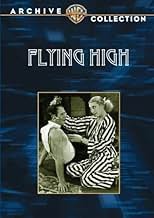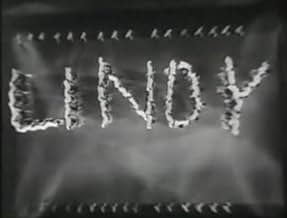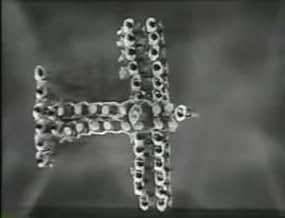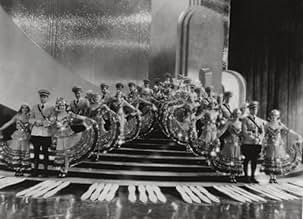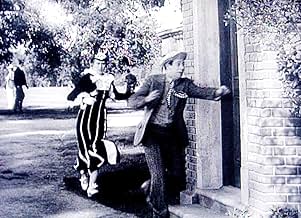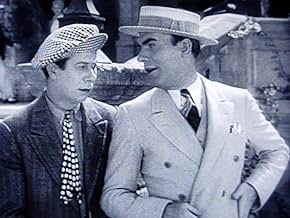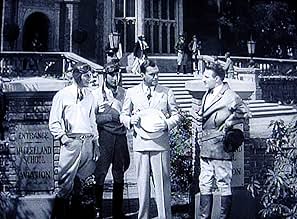Aggiungi una trama nella tua linguaAn eccentric inventor and his new flying machine are the focus of this musical comedy.An eccentric inventor and his new flying machine are the focus of this musical comedy.An eccentric inventor and his new flying machine are the focus of this musical comedy.
- Regia
- Sceneggiatura
- Star
- Premi
- 1 vittoria in totale
Gus Arnheim and His Orchestra
- Gus ArnHeim's Orchestra
- (as Gus Arnheim and his Orchestra)
Loretta Andrews
- Chorus Girl
- (non citato nei titoli originali)
Mary Ashcraft
- Chorus Girl
- (non citato nei titoli originali)
Edna Callahan
- Chorus Girl
- (non citato nei titoli originali)
Richard Carle
- Hotel Manager
- (non citato nei titoli originali)
Tommy Conlon
- Undetermined Secondary Role
- (non citato nei titoli originali)
Nick Copeland
- Aviator with the Jokester
- (non citato nei titoli originali)
Janet Currie
- Chorus Girl
- (non citato nei titoli originali)
Mary Dees
- Chorus Girl
- (non citato nei titoli originali)
Recensioni in evidenza
I saw this picture once,ages ago. Lahr is a cuckoo inventor who is trying to gain interest in his new type of dirigible(a method which became obsolete in a few years anyway). And he has to dodge spinster Charlotte Greenwood, who relentlessly pursues him and who Lahr sneeringly calls "that Giraffe".
Not that Lahr looks like a matinee idol himself, and that was part of t he problem.
While Lahr was under contract to MGM for a few years,when Red Skelton came along in the early 1940's they decided to cast their lot with Red(not a bad move). And Lahr was a dyed-in-the-wool New Yorker who preferred to make his living on the Broadway stage and shared Fred Allen's famous opinion that "California is a great place to live if you're an orange".
Lahr never played a lead role again---he was inserted as 3rd or 4th bill comedy relief in all of his best remembered films--the last one being ROSE MARIE(1954).
Not that Lahr looks like a matinee idol himself, and that was part of t he problem.
While Lahr was under contract to MGM for a few years,when Red Skelton came along in the early 1940's they decided to cast their lot with Red(not a bad move). And Lahr was a dyed-in-the-wool New Yorker who preferred to make his living on the Broadway stage and shared Fred Allen's famous opinion that "California is a great place to live if you're an orange".
Lahr never played a lead role again---he was inserted as 3rd or 4th bill comedy relief in all of his best remembered films--the last one being ROSE MARIE(1954).
FLYING HIGH (Metro-Goldwyn-Mayer, 1931), directed by Charles Reisner, marked the motion picture debut of comedian Bert Lahr (1892-1967), best known today for his memorable performance as the Cowardly Lion in the musical fantasy, THE WIZARD OF OZ (MGM, 1939). Reprising his theatrical role of Rusty from George White's 1930 Broadway musical, the screen version is very much a showcase for Lahr, with co-star Charlotte Greenwood, who can always be counted on to deliver a hilarious performance, coming a close second as a man-chasing spinster whom Lahr's character describes as a woman who "makes love like an alley cat." Greenwood's role parallels what she'd previously done with another Broadway gone Hollywood entertainer, Eddie Cantor, in PALMY DAYS (Samuel Goldwyn, 1931). While Cantor continued to perform steadily in films through most of the 1930s, FLYING HIGH was to be Lahr's sole venture into the new medium until his return to the screen by 1937 in secondary roles. What PALMY DAYS and FLYING HIGH have in common is not so much having Broadway comics in the lead and Greenwood as their foil, but the benefit of dance director Busby Berkeley, in his pre-Warner Brothers days, whose two production numbers benefits FLYING HIGH more than the plot itself.
Bert Lahr stars as Emil "Rusty" Krause, a hack-eyed inventor of the "aerocopter" who's unable to find a backer for his product. He becomes partners with "Sport" Wordell (Pat O'Brien), who doesn't have any money either. Sport acquires an investor named Fred Smith (Guy Kibbee), who's just as broke as he is. After falling in love with Smith's daughter, Eileen (Kathryn Crawford), Sport works out an angle acquiring the much needed $500 through Pansy Potts (Charlotte Greenwood), a tall, homely waitress having just inherited $1600 from her late uncle, by promising her a would-be husband in that of Rusty (by using a photo of Clark Gable!!). With additional tunes by Jimmy McHugh and Dorothy Fields, the motion picture soundtrack is as follows: "Happy Landing" (sung by Kathryn Crawford); "It Will be the First Time for Me" (sung by Charlotte Greenwood and Bert Lahr); "Examination" (recited by Charles Winninger and female patients); "Dance Until the Dawn" (sung by Kathryn Crawford) and "Happy Landing" (reprise/cast).
Kathryn Crawford, no relation to Joan, (though slightly resembling vocalist Kitty Carlisle), sings two songs choreographed by Berkeley. "Happy Landing" contains some of the best Berkeley ingredients, including overhead camera shots of the chorus resembling airplanes and spelling out the names of great aviators of Byrd, Hawks, Lindy in formation. "Dance Until the Dawn," which comes a half hour later, is another Berkeley highlight, with chorus in dance formations with airplane propellers. Portions of this sequence were used in the theatrical documentary of THAT'S DANCING (1986), with the commentator concluding that, "Flying High never really got off the ground." Although portions of this 80 minute feature tends to drag, it's brought to life by its lively tunes, for the most part are as forgotten as the film itself.
Notable comedy highlights belong to Bert Lahr. Aside from he being chased around by Greenwood (having some experience going through the motions with Eddie Cantor), and his unusual medical examination by the doctor (played by a young looking Charles Winninger), he gets his chance to demonstrate his "aerocopter" at the air show by flying high enough to be out of this world. Other participants in the cast include Hedda Hopper; Gus Arnheim and his Orchestra; Clarence Wilson and Tom Kennedy (as the bully who picks on Rusty).
Rarely seen on commercial television since the 1960s, and never distributed on video or DVD, look for FLYING HIGH the next time it tail spins on Turner Classic Movies cable station. (** landing gears)
Bert Lahr stars as Emil "Rusty" Krause, a hack-eyed inventor of the "aerocopter" who's unable to find a backer for his product. He becomes partners with "Sport" Wordell (Pat O'Brien), who doesn't have any money either. Sport acquires an investor named Fred Smith (Guy Kibbee), who's just as broke as he is. After falling in love with Smith's daughter, Eileen (Kathryn Crawford), Sport works out an angle acquiring the much needed $500 through Pansy Potts (Charlotte Greenwood), a tall, homely waitress having just inherited $1600 from her late uncle, by promising her a would-be husband in that of Rusty (by using a photo of Clark Gable!!). With additional tunes by Jimmy McHugh and Dorothy Fields, the motion picture soundtrack is as follows: "Happy Landing" (sung by Kathryn Crawford); "It Will be the First Time for Me" (sung by Charlotte Greenwood and Bert Lahr); "Examination" (recited by Charles Winninger and female patients); "Dance Until the Dawn" (sung by Kathryn Crawford) and "Happy Landing" (reprise/cast).
Kathryn Crawford, no relation to Joan, (though slightly resembling vocalist Kitty Carlisle), sings two songs choreographed by Berkeley. "Happy Landing" contains some of the best Berkeley ingredients, including overhead camera shots of the chorus resembling airplanes and spelling out the names of great aviators of Byrd, Hawks, Lindy in formation. "Dance Until the Dawn," which comes a half hour later, is another Berkeley highlight, with chorus in dance formations with airplane propellers. Portions of this sequence were used in the theatrical documentary of THAT'S DANCING (1986), with the commentator concluding that, "Flying High never really got off the ground." Although portions of this 80 minute feature tends to drag, it's brought to life by its lively tunes, for the most part are as forgotten as the film itself.
Notable comedy highlights belong to Bert Lahr. Aside from he being chased around by Greenwood (having some experience going through the motions with Eddie Cantor), and his unusual medical examination by the doctor (played by a young looking Charles Winninger), he gets his chance to demonstrate his "aerocopter" at the air show by flying high enough to be out of this world. Other participants in the cast include Hedda Hopper; Gus Arnheim and his Orchestra; Clarence Wilson and Tom Kennedy (as the bully who picks on Rusty).
Rarely seen on commercial television since the 1960s, and never distributed on video or DVD, look for FLYING HIGH the next time it tail spins on Turner Classic Movies cable station. (** landing gears)
This seems like an opened-out play. The opening out is fine. There are some highly entertaining Busby Berkeley dance routines and Pat O'Brien is always fun.
Bert Lahr is an acquired taste never acquired by me. But Charlotte Greenwood is utterly delightful in this, as the spinster who sets her sights on him as her last best chance for marriage.
Her physical, somewhat self-mocking comedy is a precuser to that of Joan Davis a decade of so later. Both are treasures.
Bert Lahr is an acquired taste never acquired by me. But Charlotte Greenwood is utterly delightful in this, as the spinster who sets her sights on him as her last best chance for marriage.
Her physical, somewhat self-mocking comedy is a precuser to that of Joan Davis a decade of so later. Both are treasures.
The 1930 musical comedy Flying High was a Broadway hit for comedian Bert Lahr, singer Kate Smith and the crack songwriting team of DeSylva, Brown & Henderson. Unfortunately when MGM filmed it, too many dandy DBH songs were thrown out and not enough others (by Dorothy Fields and Jimmy McHugh) were substituted to offset the deadening effects of the silly, contrived book and the unfunny vaudeville routines that may have left audiences howling with laughter on the Great White Way but left them yawning in movie theatres. Replacing the rotund Kate Smith with the lanky Charlotte Greenwood also did not work because Greenwood isn't extreme enough in her ungainliness to justify Lahr's deep reluctance to mate with her. I won't even bother to discuss why. The idiotic plot takes place in and around an aviation school and involves Greenwood's pursuit of Lahr, the inventor of an "aerocopter," a machine that goes up but apparently not sideways.
One thing MGM did do right was to engage Busby Berkeley for two of the dance numbers: "Happy Landing" and "We'll Dance Until the Dawn." His trademark geometric patterns, line- ups, transitions and in-camera tableaux are all in place even in this early effort; all would reappear in more polished and extravagant form over the next several years at Warner Bros. and beyond.
Two fine DBH songs, "Without Love" and "Wasn't It Beautiful While It Lasted" are served up sparingly as instrumental underscoring in a nightclub scene. Charles Winninger as the school's doctor tries but fails to rescue a half-baked recitative sequence in which he examines scantily clad female aviation students. Lahr and Greenwood get some laughs exercising their prodigious physical talents in the rowdy "The First Time for Me."
Lahr's performance in this film is often criticized for being too broad for film; that is correct, especially the "gnong-gnong-gnong" moments, but the material doesn't exactly lend itself to subtlety. Hedda Hopper appears briefly as a concerned mother. Her line readings and general bearing never changed from film to film; she talks like an elocution teacher at a microphone, a technique that served her well in her later career announcing Hollywood gossip on radio. In supporting roles Kathryn Crawford sings sweetly if off-key and Pat O'Brien remains lifeless throughout.
One thing MGM did do right was to engage Busby Berkeley for two of the dance numbers: "Happy Landing" and "We'll Dance Until the Dawn." His trademark geometric patterns, line- ups, transitions and in-camera tableaux are all in place even in this early effort; all would reappear in more polished and extravagant form over the next several years at Warner Bros. and beyond.
Two fine DBH songs, "Without Love" and "Wasn't It Beautiful While It Lasted" are served up sparingly as instrumental underscoring in a nightclub scene. Charles Winninger as the school's doctor tries but fails to rescue a half-baked recitative sequence in which he examines scantily clad female aviation students. Lahr and Greenwood get some laughs exercising their prodigious physical talents in the rowdy "The First Time for Me."
Lahr's performance in this film is often criticized for being too broad for film; that is correct, especially the "gnong-gnong-gnong" moments, but the material doesn't exactly lend itself to subtlety. Hedda Hopper appears briefly as a concerned mother. Her line readings and general bearing never changed from film to film; she talks like an elocution teacher at a microphone, a technique that served her well in her later career announcing Hollywood gossip on radio. In supporting roles Kathryn Crawford sings sweetly if off-key and Pat O'Brien remains lifeless throughout.
I have not seen FLYING HIGH yet, so no opinion there, but wanted to respond to Lonesome Prospector's ridiculous and ignorant speculation that Bert Lahr could be copying Curly Howard. Just because you saw Curly first doesn't mean he came first.
Bert Lahr began his performing career in 1910. He worked in vaudeville for 17 years, before making his Broadway debut in 1927. According to his biographer (and son) John Lahr, Bert Lahr had established his "gnong gnong" sound before 1920, as he is working it into his cop-and-dancer vaudeville act with his then-wife in the late teens and early 20's.
Curly Howard had not thought about being a performer until 1932, when brother Samuel (Shemp) left Ted Healy's Stooges, and brother Moe asked little brother Jerry (Curly) to join. At this time, Bert Lahr had already made his feature film debut, and was midway through a career as a Broadway headliner. The Stooges were scrambling through various short subject departments until they wound up at Columbia in 1934. A careful observation of their development shows that Curly had not really set his "schtick" until 1934 or 1935.
You might not think he was a big deal because he made few successful movies, but dollar for dollar Bert Lahr was a much, much bigger star than Curly Howard. Moreover, at the conclusion of his career he performed in the American premiere of WAITING FOR GODOT, did Shakespeare. Aristophanes and Feydeau. Not to say that Curly Howard couldn't have done such things, but he was long dead of a stroke, perhaps precipitated by the years of beatings he'd received from his fellow stooges.
FLYING HIGH might not be much cinematically, but it is priceless artifact of theater history, preserving Lahr as he appeared on stage in his early peak years.
Bert Lahr began his performing career in 1910. He worked in vaudeville for 17 years, before making his Broadway debut in 1927. According to his biographer (and son) John Lahr, Bert Lahr had established his "gnong gnong" sound before 1920, as he is working it into his cop-and-dancer vaudeville act with his then-wife in the late teens and early 20's.
Curly Howard had not thought about being a performer until 1932, when brother Samuel (Shemp) left Ted Healy's Stooges, and brother Moe asked little brother Jerry (Curly) to join. At this time, Bert Lahr had already made his feature film debut, and was midway through a career as a Broadway headliner. The Stooges were scrambling through various short subject departments until they wound up at Columbia in 1934. A careful observation of their development shows that Curly had not really set his "schtick" until 1934 or 1935.
You might not think he was a big deal because he made few successful movies, but dollar for dollar Bert Lahr was a much, much bigger star than Curly Howard. Moreover, at the conclusion of his career he performed in the American premiere of WAITING FOR GODOT, did Shakespeare. Aristophanes and Feydeau. Not to say that Curly Howard couldn't have done such things, but he was long dead of a stroke, perhaps precipitated by the years of beatings he'd received from his fellow stooges.
FLYING HIGH might not be much cinematically, but it is priceless artifact of theater history, preserving Lahr as he appeared on stage in his early peak years.
Lo sapevi?
- QuizThere was considerable pressure from the Hays Office to remove the examination scene from the movie, but MGM held firm, claiming they paid $100,000 for the rights to the play just for that particular scene. Eventually some aspects of that scene was removed when some exhibitors rejected the film. The TCM print contains the scene, but it may be the abbreviated version.
- BlooperTom Kennedy is menacing Bert Lahr because he threw an oil-soaked hat in his face. Pat O'Brien intervenes and punches oil-smudged Tom Kennedy in the stomach. Pat's cheeks are clean. Cut to Tom doubling over. Cut back to Pat with an oil smudge on his right cheek, even though Tom never touched him. Bert enters the shot offering Pat a hammer. Pat says "That's all right." Cut to long shot of Tom retreating and Pat wiping his face. No smudge in next close-up. So it appears there was more to the fight, but it was edited out.
- Curiosità sui creditiThe credits appear as printed on the side of a dirigible.
- ConnessioniEdited into Red-Headed Woman (1932)
- Colonne sonoreI'll Make a Happy Landing (the Lucky Day I Land You)
(1931) (uncredited)
Music by Jimmy McHugh
Lyrics by Dorothy Fields
Played during the opening credit and at the end
Sung by Kathryn Crawford and chorus and danced by the chorus in a production number
Played also as background music
Footage later used in Plane Nuts (1933)
I più visti
Accedi per valutare e creare un elenco di titoli salvati per ottenere consigli personalizzati
Dettagli
Botteghino
- Budget
- 634.000 USD (previsto)
- Tempo di esecuzione
- 1h 20min(80 min)
- Colore
Contribuisci a questa pagina
Suggerisci una modifica o aggiungi i contenuti mancanti

